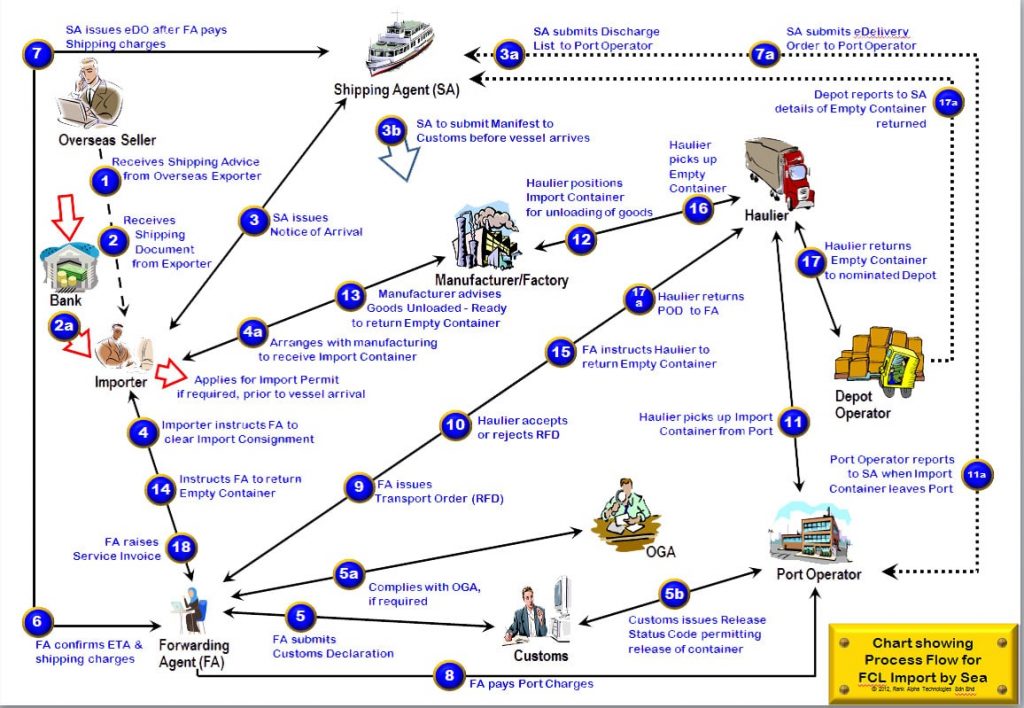Process Flow Chart for Imports
The flow charts are prepared to provide practical guidelines to port users who are involved in the export or import of goods. The guidelines are based on the practices generally found at Port Kiang though it is the objective of MITI/MPC to standardize these processes in the various ports in Malaysia so that shippers may have a clearer picture with good understanding on the processes. The shippers can then expect their shipments to be carried out within the time frame and procedures as indicated therein.
The step-by-step process flows are described in the following table for your better understanding:
| Steps No | Description of Process Activity for a Typical Import Process |
|---|---|
| 1 | Buyer/Importer receives Shipping Advice from Overseas Exporter/Seller |
| 2 | Buyer/Importer receives Shipping Documents, including Bill of Lading and Commercial Invoice from Overseas Exporter/Seller |
| 2a | In the case where Letter of Credit is involved in the transaction, Bank shall inform the Buyer/Importer when the set of documents has arrived from the Bank where the Overseas Exporter/Seller has earlier nominated the payment of the goods against the Letter of Credit issued by the Buyer/Importer. |
| 3 | Carrier/Shipping Agent issues Arrival Notice of vessel wherein shipping charges payable are stated |
| 3a | To prepare for the arrival of the vessel, the carrier/shipping agent submits a Status List document outlining the containers to be discharge to the Port Terminal for the operations planning. |
| 3b | At the same time, the carrier/shipping agent submits the cargo manifest to the Customs to match against the Import Declarations. |
| 4 | Buyer/Importer issues Forwarding Instructions to his appointed Forwarding Agents, together with all the relevant shipping documents. |
| 4a | Buyer/Importer informs the manufacturing plant or logistics warehouse on the estimated arrival of the goods. |
| 5 | Forwarding Agent submits the Import Declaration electronically to Customs using a software application, which after clearance is approved and if any customs duty or tax is due, shall also be paid via electronic fund transfer by the forwarding agent. |
| 5a | In cases where the customs clearance is dependent upon the approval of the OGA, the Forwarding Agent shall submit all relevant permit and document to the appropriate OGA for their processing and inspection (if necessary). Once their processing is completed, the OGA would submit an electronic approval into the Customs SMK system. |
| 5b | Customs, upon approving the Import Declaration, subject all other processes are completed, will issue a Release Status to the Port Terminal, which is permission for the Terminal to release the container to the Forwarding Agent's appointed haulage company. |
| 6 | Forwarding Agent checks on the ETA or vessel with the carrier/shipping agent. |
| 7 | Forwarding Agent shall arrange for the exchange of the Original Bill of Lading for the Delivery Order, which is issued by the carrier/shipping electronically to the Port Terminal. Any shipping charges payable shall be undertaken by the forwarding agent. |
| 7a | The carrier/shipping agent submits the electronic Delivery Order to the Port Terminal. |
| 8 | Forwarding Agent applies to the Port Terminal for the Gate Pass. Gate Pass is issued to the Forwarding Agent and the issuance is done when the Customs has release the Hold Status on the container. In all cases, the Forwarding Agent shall hold an active ledger account with the Terminal. |
| 9 | In parallel, the Forwarding Agent issues a Transport Order to the Container Haulage Company to pick up the container from the Terminal for delivery to the Importer/Buyer. In the submission of the order, a copy of the delivery order and the gate pass are also handed over, as these documents are required proof of the authorization for pickup. However, with the Port Klang Net system operating in Q3 2013, the usage of such paper documents would be eliminated, thus expediting the process and saving manpower resources. |
| 10 | Upon receipt of the transport order, the haulage company will on the availability of their truck against the required delivery date before confirming the acceptance of the order, as the date of delivery is usually stated in the order. |
| 11 | The haulage company will proceed to the terminal to pick up the said container. |
| 11a | Once the container leaves the gate of the terminal, an electronic message is sent to the carrier/shipping agent. |
| 12 | The haulage company will deliver the said container to the address of the manufacturing plant or logistics warehouse, stated in the transport order. |
| 13 | The manufacturing plant/logistics warehouse informs the Buyer/Importer (or the forwarding agent) that the goods have been unloaded and request that the empty container be return to the carrier/shipping agent's nominated empty container depot. |
| 14 | The Importer/Buyer informs accordingly to the Forwarding Agent to return the empty container. |
| 15 | The Forwarding Agent, in turn instructs the haulage company to return the empty container. |
| 16 | The empty container is picked up by the haulage company for return to the nominated depot. |
| 17 | The empty container is duly returned to the nominated depot. |
| 17a | Once the empty container is returned to the nominated depot, an electronic message is sent to the carrier/shipping agent confirming the details. |
| 17b | The Proof of Delivery (POD) is submitted to the forwarding agent |
| 18 | The Forwarding Agent raises his Bill of Services, outlining all the various charges he has paid on before (disbursements) and his professional fees, for submission to the Importer/Buyer. He returns also all the relevant shipping documents he has receive in the beginning from the Importer/Buyer. |

